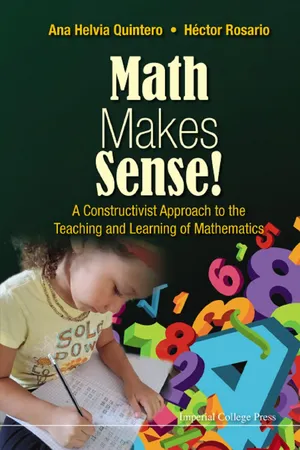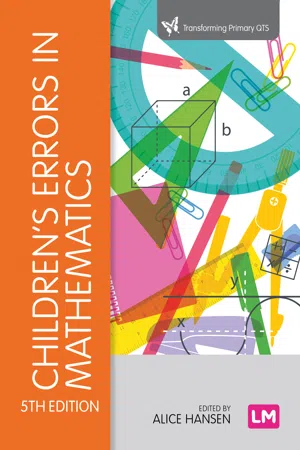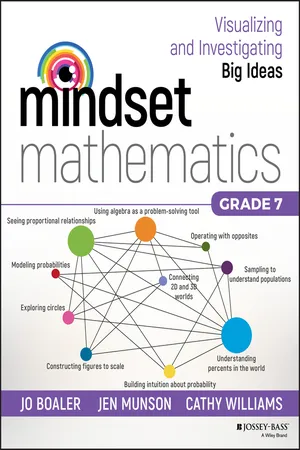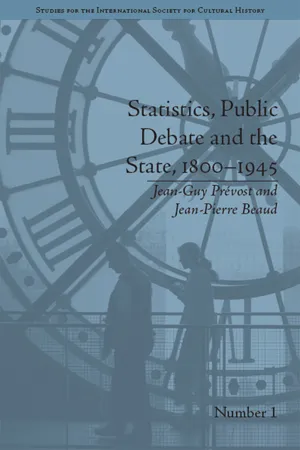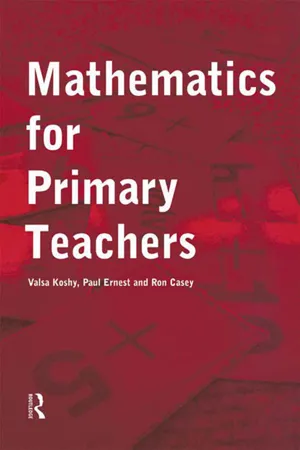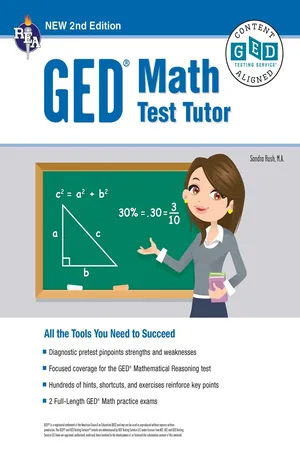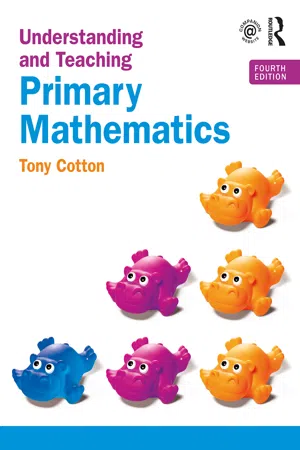Mathematics
Percentage
Percentage is a way of expressing a number as a fraction of 100. It is often used to compare quantities or represent proportions. In mathematics, percentages are commonly used in calculations involving taxes, discounts, and interest rates. They are denoted by the symbol "%," and can be converted to fractions or decimals for mathematical operations.
Written by Perlego with AI-assistance
Related key terms
Related key terms
1 of 4
Related key terms
1 of 3
11 Key excerpts on "Percentage"
- eBook - ePub
- Mark Zegarelli(Author)
- 2016(Publication Date)
- For Dummies(Publisher)
percent means “out of 100.” So if you have 50% of something, you have 50 out of 100. If you have 25% of it, you have 25 out of 100. Of course, if you have 100% of anything, you have all of it.In this chapter, I show you how to work with percents. Because percents resemble decimals, I first show you how to convert numbers back and forth between percents and decimals. No worries — this switch is easy to do. Next, I show you how to convert back and forth between percents and fractions — also not too bad. When you understand how conversions work, I show you the three basic types of percent problems, plus a method that makes the problems simple.Making Sense of Percents
The word percent literally means “for 100,” but in practice, it means closer to “out of 100.” For example, suppose that a school has exactly 100 children — 50 girls and 50 boys. You can say that “50 out of 100” children are girls — or you can shorten it to simply “50 percent.” Even shorter than that, you can use the symbol %, which means percent.Saying that 50% of the students are girls is the same as saying that of them are girls. Or if you prefer decimals, it’s the same thing as saying that 0.5 of all the students are girls. This example shows you that percents, like fractions and decimals, are just another way of talking about parts of the whole. In this case, the whole is the total number of children in the school.You don’t literally have to have 100 of something to use a percent. You probably won’t ever really cut a cake into 100 pieces, but that doesn’t matter. The values are the same. Whether you’re talking about cake, a dollar, or a group of children, 50% is still half, 25% is still one-quarter, 75% is still three-quarters, and so on.Any Percentage smaller than 100% means less than the whole — the smaller the Percentage, the less you have. You probably know this fact well from the school grading system. If you get 100%, you get a perfect score. And 90% is usually A work, 80% is a B, 70% is a C, and, well, you know the rest. - eBook - ePub
Math Makes Sense!
A Constructivist Approach to the Teaching and Learning of Mathematics
- Ana Helvia Quintero, Héctor Rosario(Authors)
- 2016(Publication Date)
- ICP(Publisher)
In fifth grade (10–11 years), we introduce the idea of Percentages. A Percentage is a ratio. To say that 30% of the group participated in an activity is the same as saying that a proportion equivalent to 30 out of 100 participated. It is important to relate Percentages to fractions and, from there, to the part–whole idea. Later, after Percentages are introduced, we integrate problems that associate them with fractions and decimals.We can start with illustrations that will later serve as stepping stones to work with Percentages.Another idea we need to explain is that Percentages, like fractions, possess an intensive property. Thus, the value of a Percentage does not depend on its quantity or size, but on the relationship between two quantities. A useful analogy is determining the quality of jelly, which does not depend on the size of the jar, but on the proportion of fruit it contains. Here is a useful exercise in this connection.
Jellies can have different levels of quality, which often depend on the proportion of fruit to other ingredients used to make it. Higher fruit content yields better jelly. (1)What do you think of the quality of these three types of strawberry jelly?6.10.1 Situation(2)Grape jelly is sold in large and small jars. Someone forgot the Percentage of fruit content in the second jar. Can you help him? Explain your reasoning to find the Percentage of fruit in the small jar.We help students notice that, in this situation, the Percentage is the same in both jars. Given that it is the same type of jelly, the size of the jar does not determine the fruit content Percentage.A Percentage is a type of ratio. Thus, when saying that a jelly has a 40% fruit content, we are saying that the relation between the amount of fruit and the whole amount of jelly in the jar is a relation of 40 to 100. This ratio can be found in a small jar as well as in a large one.The double line is a very useful analogy to discuss the concept of Percentages because it reinforces the comprehension of a Percentage as a fraction. For example, suppose we work with a group of 45 students. Of these, 15 are members of the Drawing Club. What Percentage of the class is in that club? - eBook - ePub
Pass the QTS Skills Tests with Confidence
And ace your interview
- Tony Cotton, Dave Klemm(Authors)
- 2015(Publication Date)
- Routledge(Publisher)
All you need to remember is that to simplify a fraction you need to find a number that will divide exactly into the numerator and the denominator. So: PercentagesPercentages are always ‘out of 100’. You could see these as a special sort of fraction. One where the denomination is always 100. You will know the % sign from the media and from examination results. I remember a pupil once saying to me ‘I got 58%, but I don’t know how many it was out of.’ The % sign means that whatever the test was out of it has been converted, so it is ‘out of 100’.So, for example, if I get 18 out of 25 in a test that is the same as 72%. Why? DecimalsDecimals are another way to describe parts of a whole. When we use decimals we always work with tenths, hundredths, thousandths and so on. We separate the whole numbers from the decimal fractions by a decimal point.So 5.6592 means: As before, the best way to make more sense of these ideas is to try out the examples. Question 1 At a staff meeting the mathematics coordinator gives out the following table to show the number of pupils in each class who have been identified as needing intervention support in mathematics. What Percentage of pupils in the school require intervention support? Give your answer to the nearest whole number.
Calculation strategies First we need to work out the number of pupils needing intervention as a fraction of the total number of pupils: (Always add the numbers up twice – I add them up in a different order each time to check I have the correct answer.) So, as a fraction this is 24/173. We can change this to a decimal by dividing 24 by 173. Using the calculator, this is the same as: 24/173 = 0.138728 To convert this to a Percentage we multiply by 100 (a Percentage is always ‘out of’ 100). 0.138728 × 100 = 13.8728 … To the nearest whole number, this is 14% (we always round up if the first decimal place is 5 or more).ClassNumber of pupils in classNumber of pupils needing intervention supportYear 1 28 4 Year 2 32 3 Year 3 31 5 Year 4 29 3 Year 5 27 3 Year 6 26 6 Answer = 14%Question 2 You are comparing the marks of pupils in a weekly spelling test. You want to know who has improved by at least 10%. Which pupils in the list have improved by at least 10%? - eBook - ePub
- Alice Hansen, Doreen Drews, John Dudgeon, Fiona Lawton, Liz Surtees(Authors)
- 2020(Publication Date)
- Learning Matters(Publisher)
The term ‘per cent’ means literally ‘for every hundred’. Percentages are conceptually equivalent to the part-of-a-set interpretation of fractions − if our set contains 100 objects then we can easily see that if 50 of the objects have a particular attribute then 50 per cent (%) of the set can be said to have the attribute. Equally, we can relate Percentages to the part–whole representation of fractions in that ‘the whole’ represents 100%. Percentages are used widely in ‘everyday’ life and children will have an understanding that 30% off in the sale means that the item is reduced in price. This does not mean that children understand the mathematics of Percentages, just as a young child who can ‘reel off’ the numbers to 20 may not be able to count. Like decimals, Percentages are a method of representing rational numbers, so children need to have a sound understanding of fractions before being formally introduced to Percentages.In primary school, the focus should be on helping children to understand the notion of per cent and relating this to simple fractional amounts: for example, halves, quarters and tenths. It is tempting to think that we might introduce children to a mathematical formula in order to solve more complex Percentage problems, but this should be avoided − it might be argued that teaching in this way leads to weak understanding and negative attitudes towards Percentages. Instead, just as reported earlier in the ‘Decimals’ section, it is useful to introduce equivalent fractions, decimals and Percentages together. Van den Heuvel-Panhuizen (2003) explores a Dutch Realistic Mathematics Education (RME) learning trajectory in which Grade 5 children were taught Percentages through a process drawing on the children’s own experiences of using Percentages, decimals and fractions, reporting that it was remarkable how easily the children got to work so easily ... everything happened very naturally, and it was clear from the way in which the children discussed [the assignment] ... that they knew what the Percentages represented (p20).White et al. (2007) discuss how the multiplicative relationship of Percentages causes children difficulties. They cite Misailidou and Williams (2002), who showed how 10−14-year-olds often used inappropriate additive strategies. - Jo Boaler, Jen Munson, Cathy Williams(Authors)
- 2019(Publication Date)
- Jossey-Bass(Publisher)
BIG IDEA 4 Understanding Percents in the WorldA recent survey in the UK found that 20% of adults did not know how to use Percentages. If my experience in life is anything to go by, the number of people confused by Percentages may be much higher. Judging from conversations with many people—children and adults—it seems that they are not unclear about how to enact a procedure but rather are confused by the different uses of Percentages that involve completely different calculations. The typical problem is that people do not know how to set up the calculation. Often when we help students, we skim over the differences between different uses of Percentage and instead talk through what to do in each case. But it is the setting up of the method to use that is hardest.The two main differences in the uses of Percentage are these. In some situations, we need to calculate a Percentage of something—for example, this sale item has 25% off its original price of $140. In that situation, we are calculating × 140. That calculation involves dividing by 100. But in other situations, we are told two values and asked questions such as, What is as a Percentage? In that situation we do the opposite: we multiply by 100 ( × 100 gives us 60%). If students only learn to perform calculations—sometimes dividing by 100 and sometimes multiplying by 100—but never stop to think conceptually about what is different in the two situations and why the calculations are different, they are bound to become confused. When they meet Percentages in life, often people do not know which calculation to use.In our Visualize activity, we ask students to first look at a Mondrian-style piece of art and determine the percent of each color for the painting. Our goal is for students to engage flexibly with number and percent and also connect percent to area. In the piece of art, the areas for the same colors are not adjacent, nor are they the same size. This will encourage students to visually work through determining the whole and parts of the whole and then move to percent. This is important for later study in high school, and it is a common theme on standardized tests. Students are asked to work out their own methods. After working in groups, they will later share their methods and learn from each other. Afterward they will design their own work of art for others to study and enjoy.- eBook - ePub
Statistics, Public Debate and the State, 1800–1945
A Social, Political and Intellectual History of Numbers
- Jean-Guy Prevost, Jean-Pierre Beaud(Authors)
- 2015(Publication Date)
- Routledge(Publisher)
It is precisely this process of conceptual extent of Percentages to various domains and through various paths that is explored in this chapter. This is done first by examining closely the work of early English political arithmeticians such as John Graunt and William Petty; then, we move to a North American British colony, Lower Canada (known today as Québec), and take into account a few works that illustrate the emergence of a properly statistical point of view there; and, finally, we turn back to early nineteenth-century England, at the time of the Malthusian controversy and of the first British censuses. From the original purpose of computing interest to their contemporary widespread and open-ended uses, Percentages have indeed followed a long and winding road.Proportions, Percentages and Early Political Arithmetic, 1662–99We are well aware today of the virtues of Percentages. These very peculiar fractions, with 100 as denominator, almost instantly conjure comparisons. Setting out a column of Percentages in a statistical table enables readers to get a quick idea of a distribution. Moving from raw numbers to Percentages represents a step not only towards comparison, but also towards abstraction. At first glance, one might think that, once devised, such simple statistical tools would quickly become popular and easily spread to domains from which they seem inseparable nowadays – for instance, the study of population growth. Yet, when one takes a closer look, one soon discovers that although Percentages did migrate easily to certain areas, only much later did they find their way to other domains that yet seem closely related to the former.It is generally agreed that Percentages were first used in the fields of finance and commerce, and primarily for the purpose of computing interest. According to Judy L. Klein, John Graunt, the author of the Natural and Political Observations (1662), was the first to import into political rhetoric an arithmetical technique merchants had long been familiar with, the ‘rule of three’, or ‘Merchant’s Rule’, a process that allows us, once three terms of a proportion are known, to determine the fourth.8 Klein adds: ‘Graunt’s mercantile analytical tools included comparison by division in the forms of ratios and percents, comparison by subtraction over time to follow increases and decreases’.9 But the rule of three was the most ‘spectacular’ tool in what Graunt designated the ‘Mathematiques of my Shop-Arithmetique’.10 - eBook - ePub
- Valsa Koshy, Ron Casey, Paul Ernest, Valsa Koshy, Ron Casey, Paul Ernest(Authors)
- 2014(Publication Date)
- Routledge(Publisher)
Chapter 3 Fractions, decimals and PercentagesDOI: 10.4324/9780203984062-5This chapter focuses on:- 3.1 Fractions
- 3.2 Decimals
- 3.3 Indices
- 3.4 Standard index form
- 3.5 Percentages
3.1 Fractions
In the progression of mathematics topics presented to children, the study of fractions can be the first departure from the restriction to the positive integers, which are usually referred to as whole numbers. A fraction is usually introduced as a concept enabling reference to be made to ‘a part of a whole’.For example, 3/8 can be thought of as three parts of a whole one which has been split into eight equal parts. A diagram can be used to illustrate this particular fraction.What if the top number of the fraction is an integer (whole number) greater than the bottom number of the fraction? Does this undermine the notion of a fraction being ‘a part of a whole’ ? Two examples will illustrate an appropriate answer to this question.Consider first the fraction 18/3. Its top number is greater than its bottom number. A diagram could be used to give an interpretation of this fraction.Each unit (whole) is split into three equal parts. One of those parts, in the left-most unit, is shaded. That shaded part represents 1/3. In the entire diagram there are 18 such thirds. Those 18 thirds, therefore, represent 6 units. So 18/3 = 6.What about 18 divided by 3? That is also equal to 6. So the fraction 18/3 may be interpreted in two ways:- it may be thought of as eighteen thirds or
- it may be thought of as 18÷3.
For example, if you have eighteen sweets to share between three children then your situation requires you to think of 18/3 as 18 ÷ 3. As division is repeated subtraction, you are in principle taking away three from eighteen six times, so each child gets six sweets. This illustration gives some justification for sometimes calling division by another term ‘sharing’ as well as sometimes calling subtraction by its alternative ‘taking away’. - Sandra Rush(Author)
- 2013(Publication Date)
- Research & Education Association(Publisher)
, so for 70 women, there are 30 men. If you didn’t see this right away, it’s okay—this solution actually involves algebra.
Two-thirds of a Spanish class have never studied Spanish before. In a class of 30 students, what is the ratio of those who have studied Spanish to those who haven’t?Example 3.8.Answer 3.8.2:1. Be careful to keep the numbers straight in this problem. For the number who have never studied Spanish before, it is . That means the remainder, 30 – 20 = 10 students have studied Spanish before. The question asks for “the ratio of those who have studied Spanish to those who haven’t,” so the ratio has to follow that order: 20 to 10, or 2:1.Percentages
The word percent comes from per hundred because “cent” refers to 100 (100 cents in a dollar, 100 years in a century, etc.). So a Percentage is just a way to express a fraction with 100 as the denominator. In fact, the percent sign (%) came into use as a shorthand for , with the two 0s in the % sign being the two 0s in the number 100. So to convert a Percentage to a fraction, drop the percent sign and multiply by . Therefore, 20% means , and 100% means , the whole thing.CALCULATOR PercentageSThe important keys for Percentages are (which gives “% of ”), the toggle key , and , scrolling , plus any of the basic operation keys.For example, to find 12% of 135, enter 12, , 135 and press . The screen will look like 12%135 and will display the answer 16.2. Use the toggle key ,. to change the decimal to a fraction.To change a number to a Percentage, use the combination. For example, to find the decimal .00236 expressed as a Percentage, enter .00236 and press . The result will show as 0.236%.To display a fraction as a Percentage, enter the fraction with the key, scroll right , then and press . For example, for , press 3, then , then 4, scroll right , , and press . The result looks like- eBook - ePub
- Sandra Rush(Author)
- 2017(Publication Date)
- Research & Education Association(Publisher)
, so for 70 women, there are 30 men. If you didn’t see this right away, it’s okay—this solution actually involves algebra.Two-thirds of a Spanish class have never studied Spanish before. In a class of 30 students, what is the ratio of those who have studied Spanish to those who haven’t?Example 2.8.Answer 2.8.1:2. Be careful to keep the numbers straight in this problem. For the number who have never studied Spanish before, it is . That means the remainder, 30 – 20 = 10 students have studied Spanish before. The question asks for “the ratio of those who have studied Spanish to those who haven’t,” so the ratio has to follow that order: 10 to 20, or 1:2.Percentages
The word percent comes from per hundred because “cent” refers to 100 (100 cents in a dollar, 100 years in a century, etc.). So a Percentage is just a way to express a fraction with 100 as the denominator. In fact, the percent sign (%) came into use as a shorthand for , with the two 0s in the % sign being the two 0s in the number 100. So to convert a Percentage to a fraction, drop the percent sign and multiply by . Therefore, 20% means , and 100% means , the whole thing.CALCULATOR
PercentageSThe important keys for Percentages are (which gives “% of”), the toggle key , and , scrolling , plus any of the basic operation keys.For example, to find 12% of 135, enter 12, , 135 and press . The screen will look like 12% 135 and will display the answer 16.2. Use the toggle key to change the decimal to a fraction.To change a number to a Percentage, use the combination. For example, to find the decimal .00236 expressed as a Percentage, enter .00236 and press . The result will show as 0.236%.To display a fraction as a Percentage, enter the fraction with the key, scroll right , then and press . For example, for , press 3, then , then 4, scroll right , , and press . The result looks like , and the answer is 75%. This function is not on the GED® - eBook - ePub
- Tony Cotton(Author)
- 2020(Publication Date)
- Routledge(Publisher)
Towards the end of their time in primary school, learners will have developed their understanding of number and place value to work up to 10,000,000 (10 million). They can round any number and use negative numbers in a context confidently. They can count on and back in fractions and decimals through 0 in both directions and understand the effect of multiplying and dividing by all multiples of 10.They understand the language offactorsandmultiplesand know whatprime numbersare. They are also confident in working with equivalent fractions, decimals and Percentages, knowing, for example, that 25% = 0.25 = . They will be able to express one quantity as a Percentage of another (e.g. express £400 as a Percentage of £1000).The transition to secondary education will focus on developing children’s use ofratio notation. Percentage notation is 30%, ratio notation is 30:100 and decimal notation is 0.3. Here the pupils you wish to extend can learn to reduce a ratio to its simplest form and divide a quantity into two parts in a given ratio. They will be able to use this understanding to solve simple problems involving ratio and direct proportion (e.g. identify the quantities needed to make a fruit drink by mixing water and juice in a given ratio).The next section of the chapter focuses on the big ideas of counting; place value; fractions, decimals and Percentages; and proportionality, which are at the heart of counting and understanding number. If you are confident with these ideas, you will be able to teach children successfully across the primary age range and will have a clear understanding of the development of these ideas across the 3–11 age phase.Big ideas
Counting
Many children will start school able to count, but it is important to be aware of the principles of counting, both to support the children who cannot yet count and to recognise the processes that young children who have already learnt to count have mastered. The key research which supports us in understanding the process of learning to count was undertaken by Rochel Gelman and Randy Gallistel in The Child’s Understanding of Number - eBook - ePub
- Marcus Witt, Marcus Witt(Authors)
- 2014(Publication Date)
- Learning Matters(Publisher)
Chapter 5 when operating with decimals.Grid Method of Multiplication
The grid method builds on children's understanding of place value and is a very useful introduction to multiplying decimals.Formal Written Method for Long Division
In division children will progress from thinking of a quotient as having a remainder, then as a fraction and in later primary as a decimal. See page 95 for more about this progression. 432 ÷ 15 becomes Answer: 28.8Percentages
Percentage means ‘for each hundred’ or ‘out of one hundred’. Percentages are useful because they help us to do the following.- Identify the proportion of sets – to do this we use proportions that are equivalent to fractions with a denominator of 100, or example 45 per cent (45/100) of the group are girls (9 out of 20 children are girls).
- Compare different-sized sets – we may compare the populations of two different countries using Percentages where it would not be as easy to do so when we were looking at the raw data. For example, Ecuador's population of 15,223,680 is approximately 25 per cent of that of the UK at 63,182,000. When numbers are so large, converting them to a Percentage helps us to visualise them.
- Make generalisations – a ‘50% off’ sign can be displayed in a sale and we know how much to deduct from the original price. This is easier for the shop to display than having to reduce each individual item.
Recognising and Writing Percentages
At first, children will need to be able to recognise the per cent symbol (%) and show that per cent relates to parts per hundred. It is possible to use a hundreds square or a blank 10 x 10 square to reinforce this idea. It is also very helpful for children to see the link between a fraction with a denominator of 100, a decimal and its equivalent Percentage.
Index pages curate the most relevant extracts from our library of academic textbooks. They’ve been created using an in-house natural language model (NLM), each adding context and meaning to key research topics.
Explore more topic indexes
Explore more topic indexes
1 of 6
Explore more topic indexes
1 of 4

